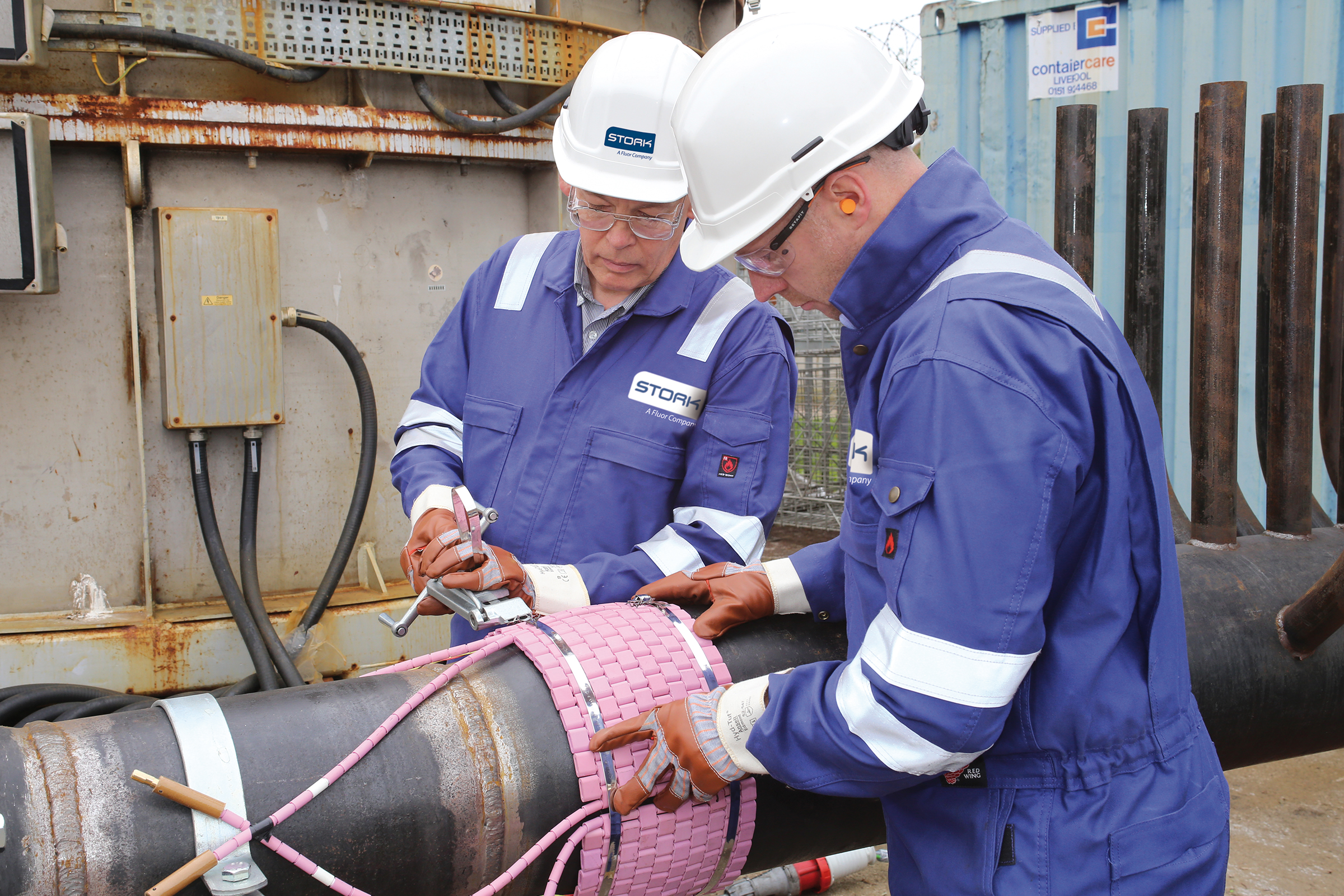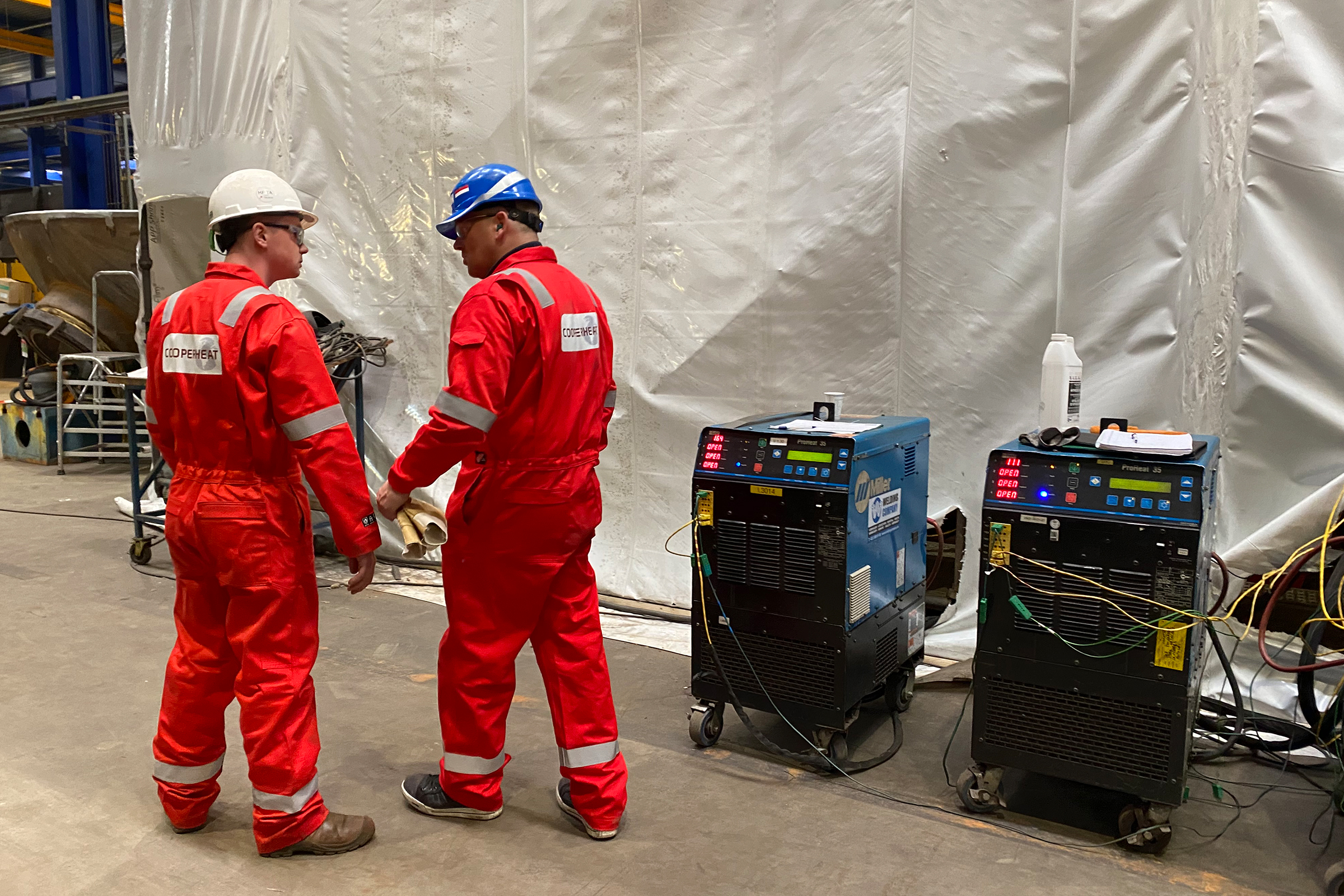Introduction to Heat Treatment
An essential step in welding and manufacturing metal constructions and equipment is the heat treatment process. During heat treatment, the material is heated up and cooled down, using predefined methods to achieve the desired mechanical properties like metallurgical structure, hardness, toughness, strength, etc. This is necessary to reduce residual stresses that occur during welding, while improving corrosion resistance and machinability.
In this blog, we explain an array of heat treatment processes that can be used to carry out heat treatment before and after welding.
1. Welding process effects
The welding process applied to metals joins two components together by fusion. The surfaces to be joined are raised locally to melting point by a source of heat provided by a variety of welding methods based on electric arc, electric resistance or flame. The process energy creates a localized molten pool into which the consumable is fed, fusing with the component surfaces and previously deposited weld metal. As the molten pool is moved along the joint axis the components are heated, non-uniformly and subsequently cooled, also non-uniformly. Neighbouring elements of material try to expand and contract by differing amounts in accordance with the sequence of the localized thermal cycle.
Characteristically, the cooling weld metal contracts under conditions of severe restraint, leading to the introduction of thermally induced stresses. As constraint tries to take place and the stress system strives to reach its lowest level to achieve stability, distortion will occur as yielding takes place. If the joint is restrained and cannot distort, then high levels of stress will occur and may lead to failure in the form of cracking.

In making a joint, gaps would occur at the plate ends if the weld metal was allowed to expand and contract without restraint. A longitudinal force on the weld is required to close the gap, giving a tensile stress whilst corresponding comprehensive stresses in the plate material providing the equilibrium. Residual stresses will act in two principal directions; longitudinal stresses parallel to the joint and transverse stresses normal to the joint.
It should not be forgotten that the value of the tensile stresses can be high, often exceeding yield point magnitude. So far, the mechanical effects of welding in the form of residual stresses have been considered, the deposition of weld metal in a molten pool and the localized melting of the joint faces of the components, along with subsequent cooling, all have metallurgical implications affecting the microstructure of these regions.
Cooling after welding can be relatively rapid. From the molten pool of weld metal, an “as cast” type of structure develops. In the region of parent metal at the fusion face raised to melting point, metallurgical restructuring take place to give the heat affected zone (HAZ). In steel, the heat affected zones are generally harder than the parent material with corresponding loss of ductility and resistance to impact.
Since the basic sources of weld failure are a consequence of thermal behaviour, a series of potential solutions arise based on the application of heat. The welding processes have to be controlled so that the residual stresses are minimized to protect the integrity of the overall fabrication and the metallurgical structures of the weld metal and heat affected zones are controlled to give properties which are not inferior to those of the parent material which have been used in the design of the product.
A series of heat treatment operations are associated with the welding processes, arising from the need to control these changes. These form the basis of the subject of Heat Treatment Engineering.
2. Preheat & post heat
2.1. Four benefits of preheating
Preheating involves raising the temperature of the parent material locally, on both sides of the joint, to a value above ambient. The need for preheat in usually determined by the pertinent fabrication code and verified by the weld procedure qualification test. Preheat may be required as an aid to welding for one of four basic reasons.
A. To control the rate of cooling
Especially in the heat affected zone, to reduce hardness. High carbon and low alloy steels harden if they are quenched from high temperatures (above cherry red). The same process can happen in a welded joint at the fusion face with the parent material. By raising the temperature of the base metal to be welded, to reduce the temperature differential between ambient and the resultant heat input, hardening may be controlled as the weld cools. Reducing hardness reduces the risk of cracking.
B. To control the diffusion rate of hydrogen in a welded joint.
The intensity of the electric arc breaks down water, present as moisture, into its base elements of hydrogen and oxygen. Both of these gases are easily dissolved into the weld metal at high temperatures, and hydrogen can play an important role in weld and heat affected zone cracking with a phenomenon known as hydrogen or cold cracking. Preheat can also help by ensuring that the weld preparation area is dry and remains dry throughout the welding operation. The presence of preheat, and associated benefits on cooling rate, helps to facilitate the diffusion of the hydrogen molecules out of the metallic structure. Moisture is also introduced from the welding consumables being present in electrode coatings and fluxes. To obtain the maximum benefits from preheat controlling hydrogen, it must be accompanied by careful controls over removal of moisture from the welding consumables by following manufacturer's baking and storage instructions.
C. To reduce thermal stresses.
Thermal strains are set up as the molten weld pool cools. Partially made welds can crack as the parent metal restrains the contraction of the weld metal and the cross-sectional are of the joint is insufficient to withstand the resultant stress. Preheat can control the level of strain by reducing temperature differentials and reducing cooling rates.
D. Compensation for heat loss.
Thicker section steels with high thermal conductivity benefit from preheating during welding, improved fusion. Where preheat is applied, every effort should be made to ensure the correct levels of particular application are attained, both uniformly over the length of the joint and for the duration of the welding process.
Preheat treatments are often specified by the client who has incorporated the heat treatment procedure / welding procedure specification.
2.2 Post heating to prevent hydrogen cracking
Post Heat. This is the term given to the extension of preheat on completion of the welding at the same or increased temperature. Its purpose is to effect diffusion of hydrogen from the joint and reduce susceptibility to the associated form of cracking. It is usually applied to the higher strength carbon manganese steels and the low alloy steels where the risk of hydrogen cracking is higher.
Post heat treatments are often specified by the client who has incorporated the heat treatment procedure / welding procedure specification.

3. Post weld heat treatment
A. What is post weld heat treatment?
This is a process commonly referred to as stress relief, so called because it is carried out at temperatures at which yield strength has fallen to a low value. If the structure is heated uniformly, the yield strength of the material around the weld is unable to support the initial deformation. Creep occurs at the elevated temperatures and strain will occur by a diffusion mechanism, relaxing the residual stresses even further. The extent to which residual stresses are relaxed will depend on temperature for any given material and on material for any given temperature. The stress distributions at the higher temperatures become more uniform and their magnitude reduces to a low level. On cooling, provided it is carried out in a controlled manner, the improved stress distribution is retained. In addition to a reduction and re-distribution of residual stresses, post weld treatments at higher permits, some tempering or ageing effects to take place. These metallurgical changes are very beneficial in that they reduce the high hardness of the as-welded structures, improving ductility and reducing the risks of brittle fracture. Post weld heat treatment has mandatory significance governed by the national standards and codes, as well as being required to offer acceptable component life in onerous environments. As with preheat , the alloying content of the steel is related to the significance of heat treatment temperature.
B. Features of post weld heat treatment.
There are five aspects to a post weld heat treatment that must be addressed. The hot zone is adequate to raise the weldment to the required temperature and provide a temperature profile therein which is uniform without creating additional undue thermally induced stresses. This aspect has greater significance in the case of localised heat treatments, but nevertheless must also be considered with furnace heat treatments. The heating and cooling rates are at least compliant with the necessary code requirements. These rates will indicate absolute maximum values, and are calculated from simple formulae related to component thickness to offer protection against thermally induced stresses. With thicker and more complex structures, an experienced heat treatment engineer may wish to consider lower rates than required by the code to ensure acceptable temperature profiles and gradients with a view to keeping these thermally induced stresses to an absolute minimum.
With localised heat treatment, the temperature gradients away from the hot zone must not be unduly severe, again the objective being the minimisation of thermally induced stresses.
The heat treatment system (including insulation), zonal division and number of thermocouples is such that the energy input and level of control is capable of enabling these objectives to be met, ensuring that the integrity of the overall structure is not jeopardised.
For local heat treatments, controls have to be implemented to provide assurance that the engineered system is capable of providing appropriate levels of performance.
Benefits of post weld heat treatment.
- Reduced residual stresses.
- Improved metallurgical structure.
- Improved corrosion resistance.
- Improved machinability.